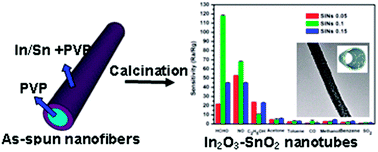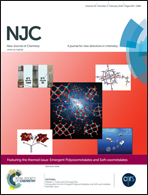Synthesis of SnO2/In2O3 hetero-nanotubes by coaxial-electrospinning method for enhanced formaldehyde response
Abstract
SnO2/In2O3 hetero-nanotubes (SINs) were successfully produced using a novel coaxial-electrospinning method with pure polyvinylpyrrolidone (PVP) plus Sn/In salt as the outer shell and PVP as the inner component. After the calcination process, these SnO2/In2O3 hetero-nanotubes with diameters of 80–120 nm and lengths of several micrometers were obtained. All the SINs are assembled by plenty of nanoparticles (10–50 nm), bringing about abundant porous structures as well as large surface areas (up to 56 m2 g−1). These SnO2/In2O3 hetero-nanotubes exhibit high response (400 at 500 ppm), low detection limit (down to 250 ppb), fast response (60 s)/recovery (97 s), good retention (94.68% for 30 day) and excellent selectivity toward formaldehyde. Gas sensing mechanism has been discussed by adjusting the amount of the two components. Based on detail investigations, it can be concluded that the enhanced response performance lies in the particle size, porous structure, surface area, and component ratio of the heterostructure.


 Please wait while we load your content...
Please wait while we load your content...